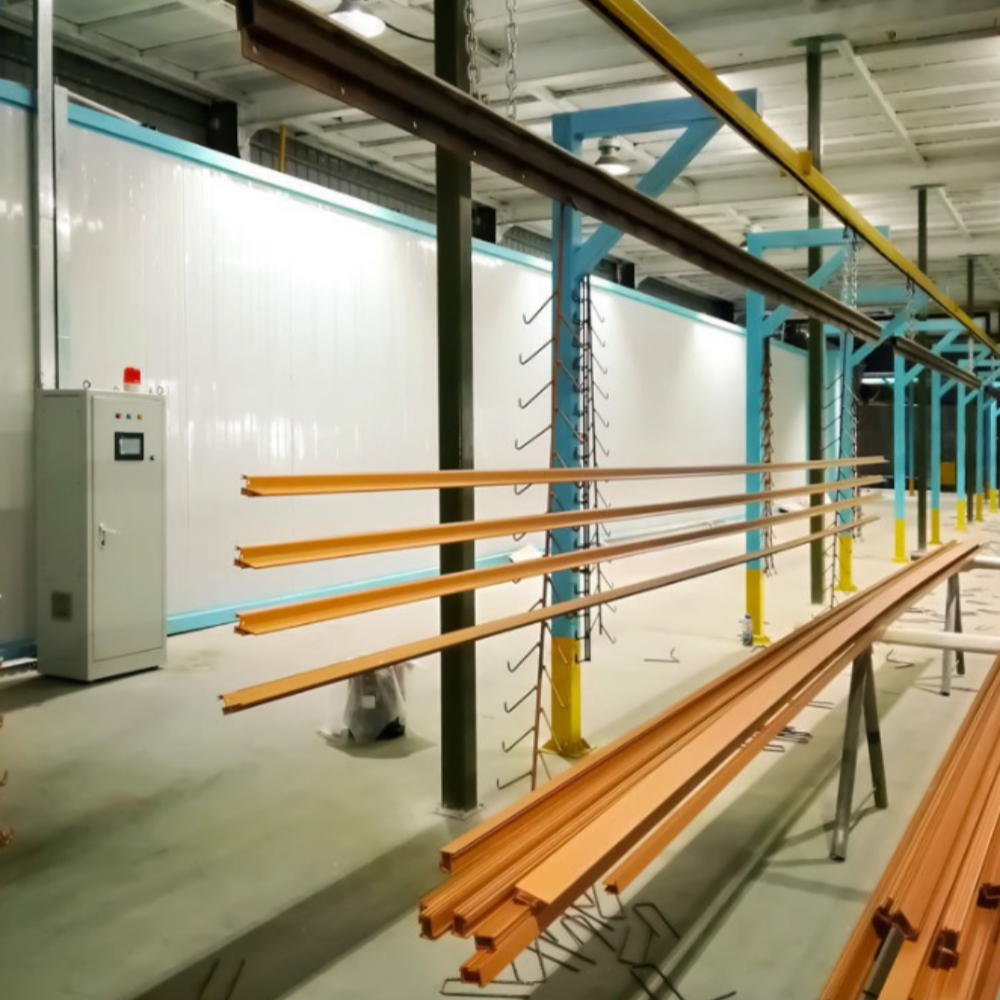Key Applications in Automotive Components and Metal Stampings
The automotive sector drives 35% of global demand for powder coating production lines (Exactitude Consultancy 2025), with applications spanning critical components:
- Engine blocks and transmission housings requiring heat resistance up to 200°C
- Suspension systems and brake calipers needing corrosion protection against road salts
- Door handles and trim pieces where aesthetic consistency impacts brand perception
This technology’s electrostatic application process ensures uniform coverage on complex geometries, particularly for high-volume metal stampings like fender panels and chassis brackets. Leading manufacturers favor powder coatings for their ability to meet stringent ISO 20482 standards for chip resistance while reducing material waste by 20–30% compared to traditional methods.
Advantages Over Liquid Paint in OEM Manufacturing Settings
Powder coating production lines eliminate volatile organic compound (VOC) emissions – a critical advantage as automakers work toward carbon-neutral factories. Key operational benefits include:
| Factor | Powder Coating | Liquid Paint | Improvement |
|---|---|---|---|
| Curing Time | 10–15 mins | 45–60 mins | 67% faster |
| First-Pass Yield | 98% | 85% | 13% gain |
| Hazardous Waste | 0 kg/m² | 0.4 kg/m² | 100% reduction |
These efficiencies explain why 8 of 10 automotive OEMs now use powder-coated finishes for underbody components exposed to harsh operating conditions. The technology also supports Just-In-Time manufacturing by enabling inline quality inspections through advanced spectral analysis tools.
Case Studies: Leading Automakers and Lightweight, Durable Finishes
One big name in European car manufacturing managed to cut down vehicle weight by about 1.2 kilograms per unit thanks to improvements in their powder coating process for aluminum alloy wheels. They achieved those premium Class A surface finishes without compromising on durability, still meeting the 1,500 hour salt spray resistance standard. Looking at what materials specialists are finding these days, it's clear that modern coating technologies are getting pretty sophisticated. Some systems now include conductive powders specifically designed for electric vehicle battery enclosures, which cleverly brings together both heat management needs and electromagnetic interference protection requirements all in one package.
Trends: Sustainability and Automation in Automotive Powder Coating
Manufacturers are moving toward these new bio-based epoxy mixes that actually cut down curing temps around 40 degrees Celsius, which means about 18 percent less energy needed for each coating operation according to those 2025 industry standards we've all been hearing about lately. The robots equipped with smart cameras can apply coatings within just 0.1 millimeter accuracy even on tricky curved parts these days. And there's something else too – those special self healing powders have really made a difference, slashing warranty issues related to car body trims by roughly 35%. All these improvements make it pretty clear why powder coating stations are becoming so important in modern automotive factories looking ahead to what vehicles might need in coming years.
Appliances and Consumer Products: Demand for Durable, Aesthetic Finishes
Powder Coating in Home Appliances: Resistance to Wear and Corrosion
For fridge, washer, and oven makers, powder coating production lines are now pretty much essential since these appliances deal with constant wear and water damage on their surfaces. Powder coatings work differently from regular liquid paint. When cured, they form one solid polymer layer instead of multiple layers that can peel off or chip easily. Industry tests show that parts like dishwasher racks and stove vents last about 40 percent longer before showing signs of wear. Major appliance companies tell us that switching to powder coated panels actually makes their products last 3 to maybe even 5 extra years in real world conditions. That kind of durability is making a big difference in customer satisfaction ratings across the board.
Expanding Use in Consumer Goods with Eco-Friendly, Scratch-Resistant Coatings
The shift toward sustainable manufacturing has accelerated adoption in smaller consumer items:
- Bicycle frames and outdoor grills leverage UV-resistant formulas to prevent fading
- Electronics enclosures use static-dissipative coatings for durability in high-traffic environments
- Furniture makers prioritize low-VOC powders to meet 92% consumer preference for non-toxic home products
Scratch-resistant formulations now enable bold color finishes on cookware and power tools without compromising structural integrity. These advancements align with circular economy principles – over 99% of overspray in powder coating production lines gets reclaimed, reducing material waste.
Construction and Architectural Sector: Long-Term Resilience in Harsh Environments
Applications in Facades, Railings, and Urban Infrastructure Projects
The powder coating production line has become pretty much standard across architectural metalwork because these coatings last way longer than most alternatives out there. Big name architects are specifying powder coated aluminum specifically for curtain wall systems lately. Meanwhile, coastal bridges get treated with zinc nickel alloys since the constant salt spray really eats away at regular materials. Take a look at those urban renewal projects happening in areas prone to flooding these days. Municipal reports show that polyester TGIC powders applied to street furniture cut down maintenance needs about two thirds compared to what they used before with traditional paint jobs. Makes sense when you think about the long term savings for cities dealing with harsh weather conditions year after year.
Weather Resistance and Growth in Sustainable Building Materials
As the construction industry moves towards circular economy models, there's growing interest in powder coated steel beams and aluminum cladding panels that can last up to 50 years even in harsh weather conditions. Recent research from 2024 looked at how these coatings perform in earthquake-prone coastal areas, and what they found was pretty impressive - corrosion issues dropped by around 83% when using powder coated parts. The numbers tell a bigger story too. Construction related corrosion costs worldwide are running over $2.5 trillion each year according to NACE data from 2023. That's why many architects now specify GREENGUARD certified powders for their projects. These special formulations stand up well against UV damage while emitting very few volatile organic compounds. Getting those LEED credits becomes much easier this way, especially important for developers building high performance green structures these days.
Furniture and Metal Fabrication: Strength Meets Design Flexibility
Rise of Powder Coated Castings and Forgings in Industrial Furniture
More and more industrial furniture makers are switching to powder coating lines these days because businesses want those tough, scratch proof surfaces everywhere from warehouses to factory floors. The stuff just holds up better than old school methods. Steel parts coated this way can take about two to three times the wear and tear in busy spots, plus production moves along five times quicker than with regular paint jobs according to some research from Ponemon back in 2023. Looking at recent data from the 2024 Industrial Design Report, nearly four out of five fabricators have made the jump to powder coated metal cabinets and workbenches lately. Makes sense really when you think about how much abuse these pieces get day after day on shop floors across the country.
- Resistance to chemical spills and UV fading
- Ability to achieve matte, glossy, or textured finishes without drips
- Compatibility with recycled steel alloys for sustainable manufacturing
Role in High-Stress Environments and Outsourcing Trends Among Fabricators
In aerospace component plants and automotive assembly lines, powder-coated structural frames endure temperatures up to 200°C without warping. This resilience drives 43% of third-party metal fabricators to invest in automated powder coating lines for outsourced projects – up from 28% in 2021. Key drivers include:
| Factor | Impact |
|---|---|
| Salt spray resistance | 15-20-year lifespan for outdoor railings and shelving |
| Color consistency | 99.8% match rate across batch productions |
| Reduced waste | 30-40% less material waste vs. conventional spray systems |
The shift toward minimalist steel furniture aligns with powder coating’s ability to deliver sleek, rust-proof finishes for modular office systems and hospital equipment. Over 60% of industrial designers now specify powder-coated aluminum or steel for load-bearing furniture joints, citing its 70% faster curing time than epoxy alternatives.
Future Outlook: Automation and Market Expansion in Powder Coating Production Line
Powder coating production lines are seeing a major shift towards automated manufacturing these days. Market research firms predict growth at around 4% annually until 2032, which would push the total market value past $3 billion dollars. The latest robotic systems have gotten really good at applying coatings efficiently, hitting nearly 98% transfer efficiency rates. This means less wasted material floating around workshops and factories, something that becomes increasingly important as environmental regulations continue to tighten across industries. Smart cameras powered by artificial intelligence can check coating thickness on the fly during production runs, slashing rework needs by about a fifth in car plants and appliance factories. Over in the Asia-Pacific region, modular production setups are becoming popular among manufacturers who need quicker response times for building materials and everyday products. As companies adopt Industry 4.0 technologies, they're installing Internet of Things sensors throughout their facilities. These sensors help predict when equipment might fail before it actually breaks down, keeping operations running smoothly. This matters especially for solar panel makers who require special coatings that resist corrosion on metal frames exposed to harsh outdoor conditions for decades.
FAQ
What are the primary applications of powder coating in the automotive industry?
Powder coating is primarily used in the automotive industry for engine blocks, transmission housings, suspension systems, brake calipers, door handles, and trim pieces. These applications benefit from heat resistance, corrosion protection, and aesthetic consistency.
Why do manufacturers prefer powder coating over liquid paint?
Manufacturers prefer powder coating over liquid paint due to its environmental benefits, faster curing times, higher first-pass yield, and zero hazardous waste production.
How does powder coating contribute to sustainability in manufacturing?
Powder coating contributes to sustainability by reducing VOC emissions, lowering energy consumption with bio-based epoxy mixes, and reclaiming over 99% of overspray, thereby minimizing material waste.
What are the benefits of powder coating in appliances and consumer products?
In appliances and consumer products, powder coating provides resistance to wear and corrosion, extends product lifespan, and offers eco-friendly, scratch-resistant finishes that align with consumer preferences for non-toxic products.
How does powder coating enhance the durability of construction materials?
Powder coating enhances the durability of construction materials by offering long-term resilience in harsh environments, reducing corrosion-related issues, and extending the lifespan of steel beams and aluminum cladding panels.
What future trends are expected in the powder coating production line market?
The powder coating production line market is expected to see growth driven by automation, increased efficiency, and the adoption of Industry 4.0 technologies, with a predicted annual growth of 4% until 2032.
Table of Contents
- Key Applications in Automotive Components and Metal Stampings
- Advantages Over Liquid Paint in OEM Manufacturing Settings
- Case Studies: Leading Automakers and Lightweight, Durable Finishes
- Trends: Sustainability and Automation in Automotive Powder Coating
- Appliances and Consumer Products: Demand for Durable, Aesthetic Finishes
- Construction and Architectural Sector: Long-Term Resilience in Harsh Environments
- Furniture and Metal Fabrication: Strength Meets Design Flexibility
- Future Outlook: Automation and Market Expansion in Powder Coating Production Line
-
FAQ
- What are the primary applications of powder coating in the automotive industry?
- Why do manufacturers prefer powder coating over liquid paint?
- How does powder coating contribute to sustainability in manufacturing?
- What are the benefits of powder coating in appliances and consumer products?
- How does powder coating enhance the durability of construction materials?
- What future trends are expected in the powder coating production line market?

